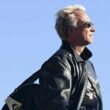By Inma A ́ lvarez
Dance artists express their dance ideas by means of moving bodies but these do not necessarily refer to human bodies, as in the case of formalist and abstractionist dances. Choreographers have played with many degrees of separation between the natural body and the artistic body, withthe ambiguities of the medium, and with the challenges of escaping from the presence of the human body (physical and emotional) in their work. In theatre dance the artistic moving body is expressive of the choreogra- pher’s creative ideas which might not express any human content at all, or might aim at decentralise it, objectify it, dissolve it, trace it, or virtualise it.
Expressivity in dance art is not primarily of a natural kind. Expressiveness is the communicative act of an artist, and in dance this means that a choreographer articulates her or his dance ideas knitting the strands of the dance medium into the work of art. In theatre dance we are confronted with artistic expression but a corporeal expressiveness emerges and affects our perception of the work. Dance natural and artistic personas permeate our experiences of dance art. The natural body becomes a dancing body that expresses dance ideas through specific techniques and styles and appropriate representations and actions. Whatever roles are intended for the natural and artistic bodies in dance pieces, it could be said that we find dance expressive by the interplay between them.
Despite the usual distance in dance art between different personas, it seems that the mere presence of the body has potent consequences for our perception of dance works because we will always tend to perceive and appreciate the human being executing the movement both at a physical and affective level. Dance audiences have a tendency to look for the real body of the dancer and infuse it with social and aesthetic value and meaning. Therefore, understanding not dance works themselves but experiences of dance performances becomes a process where both natural and artistic bodies play a role.










